Farmers and contractors in Ireland are knowledgeable of horsepower and what is under the bonnet of the tractor, but how many truly consider stopping power? By this, I mean brake performance and what’s under the wheel hub on tankers and trailers.
While it’s important to have the power to pull, it is equally as important to have the capability to halt.
It is vital that all within the farming community understand that full loads combined with high speed mean a lot of heat and energy is created when braking.
This energy needs to be balanced appropriately between the tractor and the trailer to achieve safe and effective braking performance, so energy is dissipated properly and not left mainly to the tractor.
Ineffective braking may lead to poor safety for all road users and potentially very costly downtime to owners, with possible transmission rebuilds a consequence.
Regardless of the tractor manufacturer, it has its own internal brake components to help reduce its inertia but not the additional 15t to 20t moving at speed behind it, hence why the effectiveness of the trailer’s own braking systems are so important to consider.
Larger tractors, larger loads
As tractors have increased exponentially over the years in power, weight and forward speed, as well as the trailers and tankers in tow, the question is, have the unseen components underneath bulked up sufficiently to stop them?
In an internal combustion engine, piston size, the number of cylinders, piston velocity and stroke create power.
Similarly in a trailer, shoe size, the number of hubs and activation rate, plus force applied, create braking effort and hence performance.
Likewise, we accept that timing within an engine is fundamental to peak efficiency.
This same rule applies to braking so that all brake shoes tow equally and in unity.
The standard at which brakes operate is known as the braking efficiency and is the maximum force capable of being developed by the brakes expressed as a percentage of the maximum gross weight of the vehicle.
For a typical tandem-axle trailer with eight shoes at 175mm, width has much greater surface area to bite down than eight shoes at a 60mm working width.
Due diligence is most definitely advised, as one should note the plated speed on trailed machinery for its type approval category.
Penny wise, pound foolish
Basic knowledge to most might be steered axle or conventional.
Hubs may be viewed as six- or eight-stud, which is typically classified as agricultural and 10-stud accepted as commercial. This should be seen as a guide but to be 100% sure, you need to know what is behind the hub.
For example, shoe size and width, lining quality, S cam actuation, automatic slack adjusters, large diameter brake actuators, relevant-sized pipe work and quality control systems should be considered.
Knorr-Bremse or Wabco manufacture quality load-sense valves and emergency breakaway relay valves, and these are OEM components with a known pedigree from the trucking industry.
There is no issue with cheaper Indian- or Chinese-manufactured axles and control systems under domestically built equipment, but only if they conform to relevant ISO tests and are examined and accredited accordingly.
The question must be asked: if the shoes and other critical braking parts can’t cope in the first place with the weight and speed, what then?
In short, you should consider upgrading the trailer or at the very least the brake components, checking brake efficiency and being smarter about driving style.
If not, your tractor brakes are going to wear prematurely.
The knock-on effect means this will overload the tractor’s own brake discs.

Hi-speed commercial size shoe (175mm) v Agri spec shoe (60mm).
This chain reaction event leads to brake fade in tractors and increased stopping distances and potential rapid internal degradation of hydraulic/transmission components, plus the prospect of road traffic accidents increasing.
Slurry tankers are harder on tractors
If the trailer and what is going on underneath it hasn’t already got your attention, then beware, because the typical slurry tanker is the real ‘bad boy’ here if pulled at speeds above its plate rating, has poor-quality brake components or the brake efficiency is below par.
If this machine is used on farm and towed sensibly on flat terrain, then generally there are no problems once proper maintenance is adhered to.
Today, most slurry tankers are in the region of 2,000 to 2,600 gallons, plus a dribble bar/trailing shoe and run on a single axle, therefore, two hubs or four shoes stopping in the region of 20 tonnes.
While the current legislation allows this assembly style for road use, simple physics doesn’t favour it.
“The braking system energy, when stopping from 50km/h, is approximately 2.5 times greater than a speed of 30km/h.”
Narrow configuration
Speed certainly matters! If these brake shoes are a narrow configuration and pulled at 50km/h, it is a recipe for big problems at some point. Catastrophic brake disc failure on new tractors between 100 and 250 hours isn’t unheard of as a consequence of poor tanker brakes. Worse again is the financial headache.
The contents within a tanker are a floating load, so the energy is ricocheted through the drawbar into the tractor braking system. This needs to be considered accordingly by those hauling on roads at speed.
Along with good maintenance and adhering to the rated speed, good practice is slowing down by throttling back the engine and decelerating wisely through the tractor transmission to reduce the momentum more naturally rather than full throttle and late braking, if this can at all be avoided.
Drivers resting their leg on the brake to hold the momentum back on hill descends can heat the lining and glaze the shoe. Selecting the right gear and stabbing the brake pedal can be a much more effective method.
Control system and actuation time
Before 2020, single-line hydraulic brakes were the norm for most 40km/h tractors, and this is usually actuated at 150-bar maximum pressure. In TMR-classified tractors (mainly 2020 onwards) air brakes or dual-line hydraulic can be supplied for 40km/h machines, depending on make/model.
Air is standard for 50km/h machines as dual-line air systems on trailers are already on the market here. It is also fast-acting and abundant in the atmosphere and these systems typically operate at around eight-bar pressure depending on the load-sensing valve setting.
Remember, the tractor and trailer combination should brake in unison whether it’s controlled by hydraulic oil or air.
A flat-cam in a traditional agricultural spec axle does not actuate in the same way or as aggressively as an S-cam found on what is considered a commercial axle.

S Cam (in blue on rollers) v Agri axle with flat cam.
ABS or anti-lock braking is a more advanced technology and involves wheel sensors to monitor hub movement and prevent friction loss of the tyre and ground, so maximum braking is applied in a pulsing method and tyres won’t lock up and scrub.
Pressure
Most agricultural trailers use a mechanical load-sense valve, which is coupled to the axle or drawbar and varies pressure to the load inside the trailer.
TMR-built tractors have a proportional brake pressure increasing with brake pedal position rather than on-off systems on older machines. Class R agricultural trailers and towed equipment have a different type of approval if manufactured after 1 January 2016 to before this period which, if buying secondhand, potential buyers need to be mindful of.
Today’s towed equipment falls into different categories, recognised as R1 to R4 for weight and speed.
In short, service brake efficiency requirements should be a minimum of 25% for oil-operated equipment.
For air systems, a minimum of 45% service brake efficiency is required, depending which load and speed R category it is type-approved for.
Also important to note are park brake and brake-away efficiency ratings.
It is critical to make sure that air brake couplers are a proper match, as tractors often come into this country with European configuration palm couplers and they need to match the trailer’s male/female couplings properly as, if they don’t, this can also lead to slower brake momentum and release.
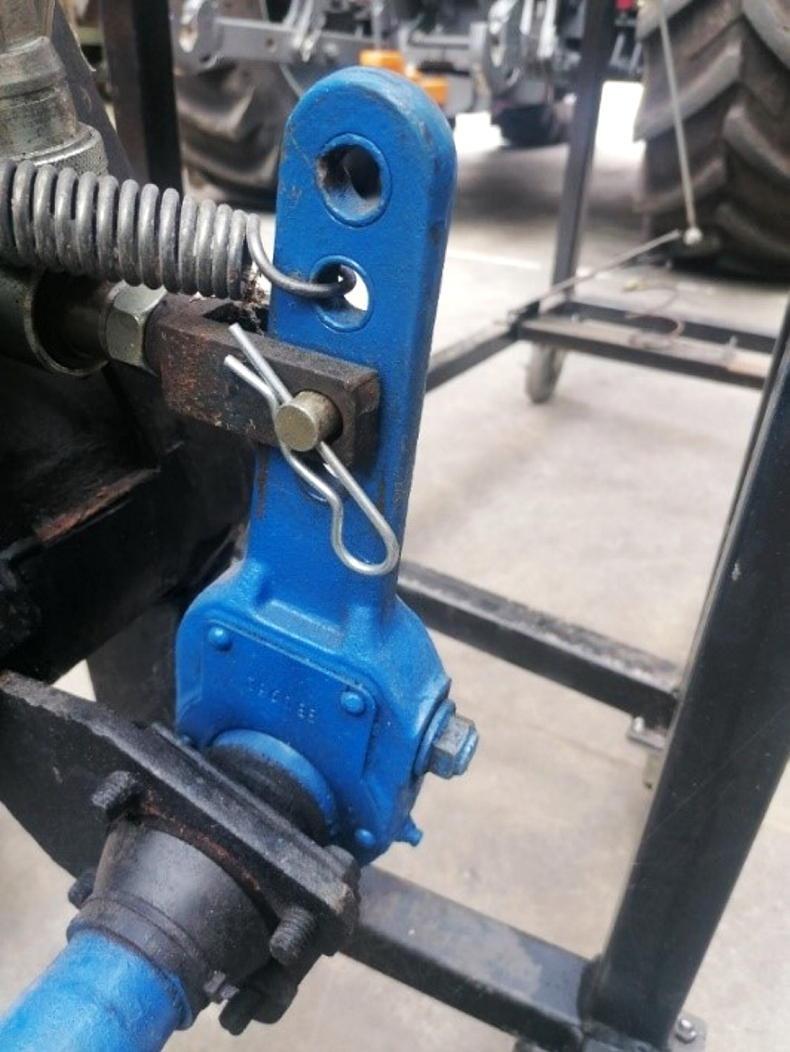
Automatic slack adjuster.
In the ideal world, the load-sense valve would be calibrated to the tractor during initial setup or during pre-delivery inspection (PDI).
Always follow manufacturers’ guidelines for maintenance, but it is fair to say that these are general enough pre-checks. Assuming the tractor’s own air and hydraulic brake system is healthy, there are a few items that need consideration.
Daily checks such as lights, indicators, draining air tanks, greasing moving parts and checking wheel nuts are essential.
Check the hubs by hand after the first load to see that they are all lukewarm at the touch.
More rigorous testing must be considered and pay particular attention to glazed shoes, over tightening and stretching wheel studs, impact tools cracking drums, watching for wear limits on shoe linings and shoe to drum clearances.
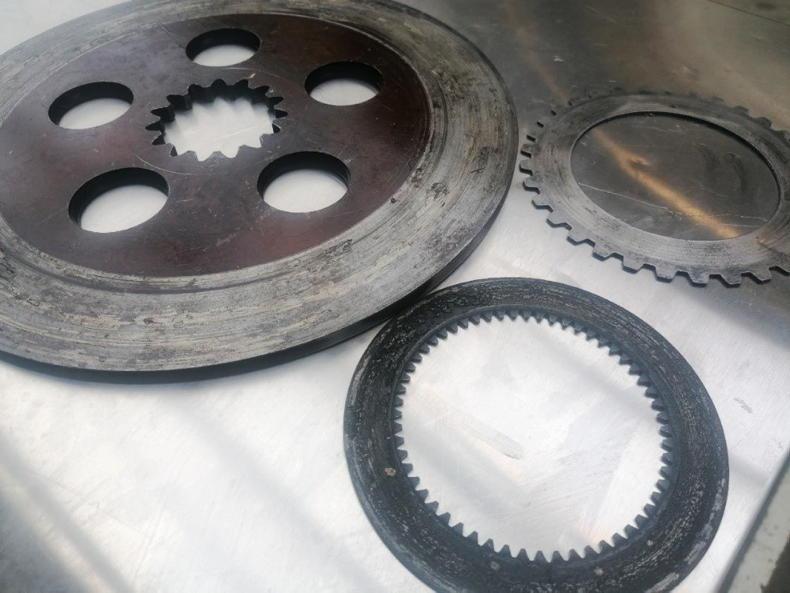
Worn brake disc and transmission components.
Testing brakes with an empty trailer rolling out of the shed before leaving the yard on the hydraulic spool valve is not a valid test on modern machinery, as trailers must be loaded, set up properly and checked using a rolling road or decelerometer to calculate its true brake efficiency.
Breakaway cables and hand brakes are also essential items to verify. Operators should get daily, weekly and yearly check sheets and educate drivers on the effects of speed and incorrectly operating brakes.
Granning Axles and Suspensions Ltd, based in Naas, Co Kildare have designed and tested a new axle, allowing customers to monitor brake performance remotely while on the move through telematics.
It allows operators to make sure all wheel hubs are individually monitored, so peak brake efficiency is maintained, and immediate attention and adjustments can be made if performance levels drop off. Further data can be obtained through the new suspension system in terms of yield as the trailer can be weighed on the go.
Should farmers and all contractors be rewarded through TAMS for the purchase of equipment with “smart axles” and high-quality braking systems which are rigorously tested?
The current TAMS looks at technology and farm safety. This new axle technology ticks both boxes and may kill two birds with one stone, thanks to the safety and data capability.
One faulty trailer brake could
destroy a tractor
The farming community should look to the truck industry and consider dynamic brake testing trailed equipment yearly.
Customers need to ask questions when investing in trailers and tankers.
What brand is the axle and where was it built? What brand are the control components? Is there a laden brake efficiency test report for it and who did the PDI on it? You should consider asking for a signed copy of it. Is there a check sheet for the specific maintenance items?
It only takes one faulty or weak brake system across multiple trailers and tankers to destroy a tractor.
The warranty on new tractors may be void and manufacturers may look to do a brake performance test on the trailed equipment belonging to the owner if issues arise.
The RSA website and booklet on class R trailers also provides a lot of details of current legislation for agricultural towed equipment.
In the meantime, make sure the setup is correct and brakes are performing appropriately for the remainder of the season. We all need to box clever and be more mindful with regular and good trailed equipment health checks, smarter initial buying, upgrading older equipment’s running gear and reducing forward speeds properly.
The correct brake maintenance of trailed machinery is critical. When buying new trailers and slurry tankers, pay more attention to the running gear, ie the axle and component brands, used. Ask if there is a laden brake efficiency test report. Is there a checklist of specific maintenance items? Remember, one weak braking system on a trailer or tanker could be enough to destroy a tractor and cause the warranty to be void.
Farmers and contractors in Ireland are knowledgeable of horsepower and what is under the bonnet of the tractor, but how many truly consider stopping power? By this, I mean brake performance and what’s under the wheel hub on tankers and trailers.
While it’s important to have the power to pull, it is equally as important to have the capability to halt.
It is vital that all within the farming community understand that full loads combined with high speed mean a lot of heat and energy is created when braking.
This energy needs to be balanced appropriately between the tractor and the trailer to achieve safe and effective braking performance, so energy is dissipated properly and not left mainly to the tractor.
Ineffective braking may lead to poor safety for all road users and potentially very costly downtime to owners, with possible transmission rebuilds a consequence.
Regardless of the tractor manufacturer, it has its own internal brake components to help reduce its inertia but not the additional 15t to 20t moving at speed behind it, hence why the effectiveness of the trailer’s own braking systems are so important to consider.
Larger tractors, larger loads
As tractors have increased exponentially over the years in power, weight and forward speed, as well as the trailers and tankers in tow, the question is, have the unseen components underneath bulked up sufficiently to stop them?
In an internal combustion engine, piston size, the number of cylinders, piston velocity and stroke create power.
Similarly in a trailer, shoe size, the number of hubs and activation rate, plus force applied, create braking effort and hence performance.
Likewise, we accept that timing within an engine is fundamental to peak efficiency.
This same rule applies to braking so that all brake shoes tow equally and in unity.
The standard at which brakes operate is known as the braking efficiency and is the maximum force capable of being developed by the brakes expressed as a percentage of the maximum gross weight of the vehicle.
For a typical tandem-axle trailer with eight shoes at 175mm, width has much greater surface area to bite down than eight shoes at a 60mm working width.
Due diligence is most definitely advised, as one should note the plated speed on trailed machinery for its type approval category.
Penny wise, pound foolish
Basic knowledge to most might be steered axle or conventional.
Hubs may be viewed as six- or eight-stud, which is typically classified as agricultural and 10-stud accepted as commercial. This should be seen as a guide but to be 100% sure, you need to know what is behind the hub.
For example, shoe size and width, lining quality, S cam actuation, automatic slack adjusters, large diameter brake actuators, relevant-sized pipe work and quality control systems should be considered.
Knorr-Bremse or Wabco manufacture quality load-sense valves and emergency breakaway relay valves, and these are OEM components with a known pedigree from the trucking industry.
There is no issue with cheaper Indian- or Chinese-manufactured axles and control systems under domestically built equipment, but only if they conform to relevant ISO tests and are examined and accredited accordingly.
The question must be asked: if the shoes and other critical braking parts can’t cope in the first place with the weight and speed, what then?
In short, you should consider upgrading the trailer or at the very least the brake components, checking brake efficiency and being smarter about driving style.
If not, your tractor brakes are going to wear prematurely.
The knock-on effect means this will overload the tractor’s own brake discs.

Hi-speed commercial size shoe (175mm) v Agri spec shoe (60mm).
This chain reaction event leads to brake fade in tractors and increased stopping distances and potential rapid internal degradation of hydraulic/transmission components, plus the prospect of road traffic accidents increasing.
Slurry tankers are harder on tractors
If the trailer and what is going on underneath it hasn’t already got your attention, then beware, because the typical slurry tanker is the real ‘bad boy’ here if pulled at speeds above its plate rating, has poor-quality brake components or the brake efficiency is below par.
If this machine is used on farm and towed sensibly on flat terrain, then generally there are no problems once proper maintenance is adhered to.
Today, most slurry tankers are in the region of 2,000 to 2,600 gallons, plus a dribble bar/trailing shoe and run on a single axle, therefore, two hubs or four shoes stopping in the region of 20 tonnes.
While the current legislation allows this assembly style for road use, simple physics doesn’t favour it.
“The braking system energy, when stopping from 50km/h, is approximately 2.5 times greater than a speed of 30km/h.”
Narrow configuration
Speed certainly matters! If these brake shoes are a narrow configuration and pulled at 50km/h, it is a recipe for big problems at some point. Catastrophic brake disc failure on new tractors between 100 and 250 hours isn’t unheard of as a consequence of poor tanker brakes. Worse again is the financial headache.
The contents within a tanker are a floating load, so the energy is ricocheted through the drawbar into the tractor braking system. This needs to be considered accordingly by those hauling on roads at speed.
Along with good maintenance and adhering to the rated speed, good practice is slowing down by throttling back the engine and decelerating wisely through the tractor transmission to reduce the momentum more naturally rather than full throttle and late braking, if this can at all be avoided.
Drivers resting their leg on the brake to hold the momentum back on hill descends can heat the lining and glaze the shoe. Selecting the right gear and stabbing the brake pedal can be a much more effective method.
Control system and actuation time
Before 2020, single-line hydraulic brakes were the norm for most 40km/h tractors, and this is usually actuated at 150-bar maximum pressure. In TMR-classified tractors (mainly 2020 onwards) air brakes or dual-line hydraulic can be supplied for 40km/h machines, depending on make/model.
Air is standard for 50km/h machines as dual-line air systems on trailers are already on the market here. It is also fast-acting and abundant in the atmosphere and these systems typically operate at around eight-bar pressure depending on the load-sensing valve setting.
Remember, the tractor and trailer combination should brake in unison whether it’s controlled by hydraulic oil or air.
A flat-cam in a traditional agricultural spec axle does not actuate in the same way or as aggressively as an S-cam found on what is considered a commercial axle.

S Cam (in blue on rollers) v Agri axle with flat cam.
ABS or anti-lock braking is a more advanced technology and involves wheel sensors to monitor hub movement and prevent friction loss of the tyre and ground, so maximum braking is applied in a pulsing method and tyres won’t lock up and scrub.
Pressure
Most agricultural trailers use a mechanical load-sense valve, which is coupled to the axle or drawbar and varies pressure to the load inside the trailer.
TMR-built tractors have a proportional brake pressure increasing with brake pedal position rather than on-off systems on older machines. Class R agricultural trailers and towed equipment have a different type of approval if manufactured after 1 January 2016 to before this period which, if buying secondhand, potential buyers need to be mindful of.
Today’s towed equipment falls into different categories, recognised as R1 to R4 for weight and speed.
In short, service brake efficiency requirements should be a minimum of 25% for oil-operated equipment.
For air systems, a minimum of 45% service brake efficiency is required, depending which load and speed R category it is type-approved for.
Also important to note are park brake and brake-away efficiency ratings.
It is critical to make sure that air brake couplers are a proper match, as tractors often come into this country with European configuration palm couplers and they need to match the trailer’s male/female couplings properly as, if they don’t, this can also lead to slower brake momentum and release.

Automatic slack adjuster.
In the ideal world, the load-sense valve would be calibrated to the tractor during initial setup or during pre-delivery inspection (PDI).
Always follow manufacturers’ guidelines for maintenance, but it is fair to say that these are general enough pre-checks. Assuming the tractor’s own air and hydraulic brake system is healthy, there are a few items that need consideration.
Daily checks such as lights, indicators, draining air tanks, greasing moving parts and checking wheel nuts are essential.
Check the hubs by hand after the first load to see that they are all lukewarm at the touch.
More rigorous testing must be considered and pay particular attention to glazed shoes, over tightening and stretching wheel studs, impact tools cracking drums, watching for wear limits on shoe linings and shoe to drum clearances.

Worn brake disc and transmission components.
Testing brakes with an empty trailer rolling out of the shed before leaving the yard on the hydraulic spool valve is not a valid test on modern machinery, as trailers must be loaded, set up properly and checked using a rolling road or decelerometer to calculate its true brake efficiency.
Breakaway cables and hand brakes are also essential items to verify. Operators should get daily, weekly and yearly check sheets and educate drivers on the effects of speed and incorrectly operating brakes.
Granning Axles and Suspensions Ltd, based in Naas, Co Kildare have designed and tested a new axle, allowing customers to monitor brake performance remotely while on the move through telematics.
It allows operators to make sure all wheel hubs are individually monitored, so peak brake efficiency is maintained, and immediate attention and adjustments can be made if performance levels drop off. Further data can be obtained through the new suspension system in terms of yield as the trailer can be weighed on the go.
Should farmers and all contractors be rewarded through TAMS for the purchase of equipment with “smart axles” and high-quality braking systems which are rigorously tested?
The current TAMS looks at technology and farm safety. This new axle technology ticks both boxes and may kill two birds with one stone, thanks to the safety and data capability.
One faulty trailer brake could
destroy a tractor
The farming community should look to the truck industry and consider dynamic brake testing trailed equipment yearly.
Customers need to ask questions when investing in trailers and tankers.
What brand is the axle and where was it built? What brand are the control components? Is there a laden brake efficiency test report for it and who did the PDI on it? You should consider asking for a signed copy of it. Is there a check sheet for the specific maintenance items?
It only takes one faulty or weak brake system across multiple trailers and tankers to destroy a tractor.
The warranty on new tractors may be void and manufacturers may look to do a brake performance test on the trailed equipment belonging to the owner if issues arise.
The RSA website and booklet on class R trailers also provides a lot of details of current legislation for agricultural towed equipment.
In the meantime, make sure the setup is correct and brakes are performing appropriately for the remainder of the season. We all need to box clever and be more mindful with regular and good trailed equipment health checks, smarter initial buying, upgrading older equipment’s running gear and reducing forward speeds properly.
The correct brake maintenance of trailed machinery is critical. When buying new trailers and slurry tankers, pay more attention to the running gear, ie the axle and component brands, used. Ask if there is a laden brake efficiency test report. Is there a checklist of specific maintenance items? Remember, one weak braking system on a trailer or tanker could be enough to destroy a tractor and cause the warranty to be void. 








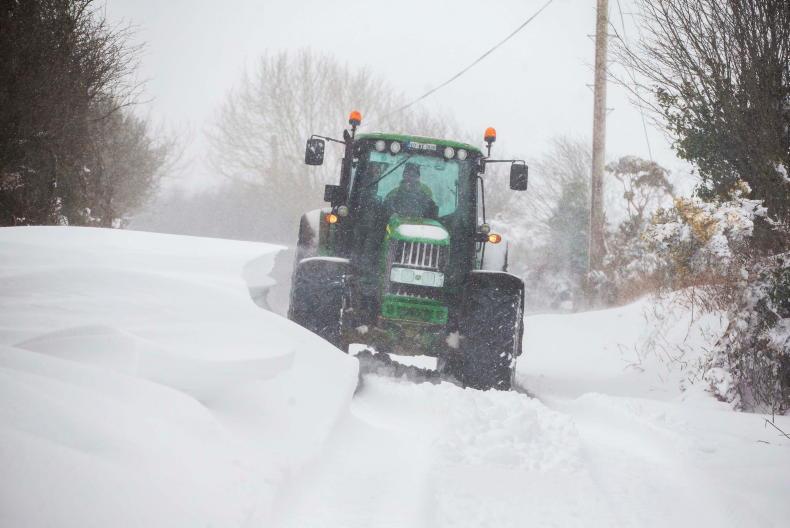
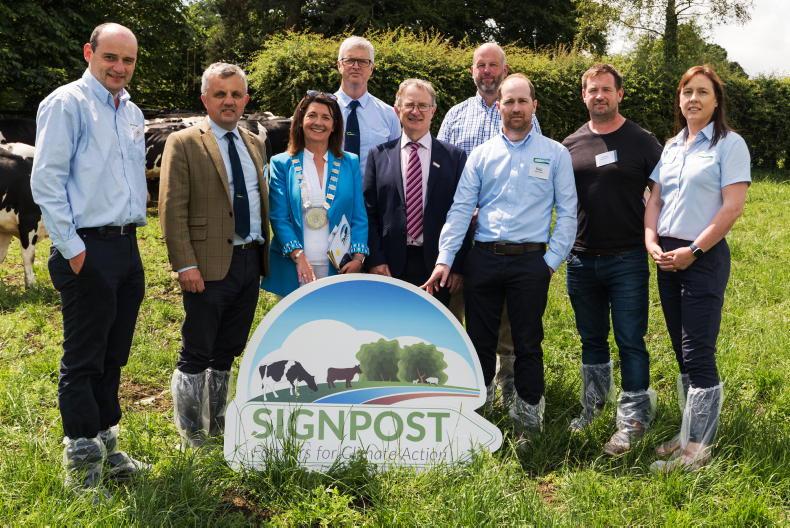
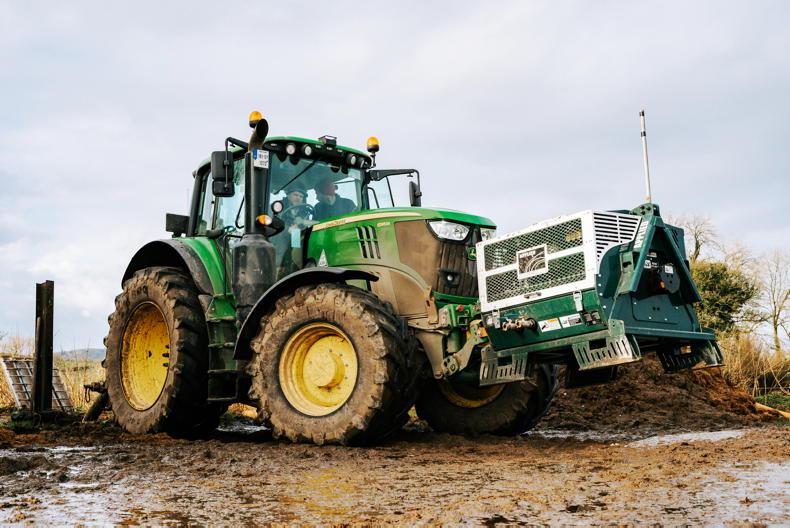
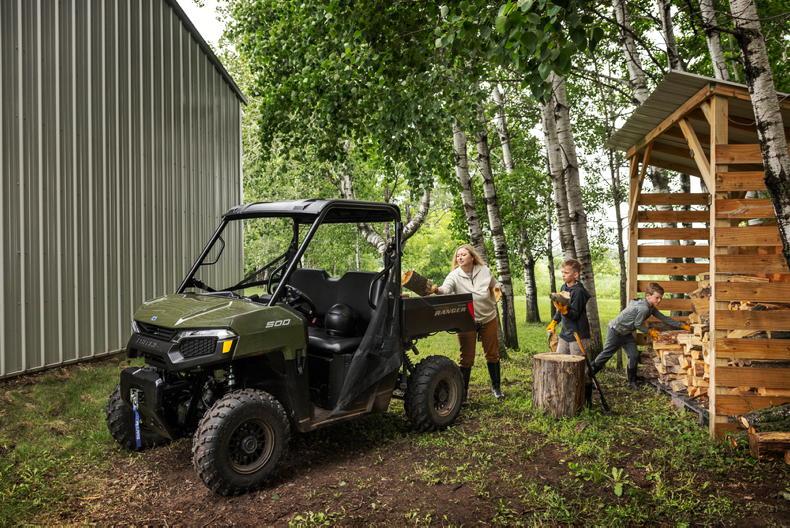
SHARING OPTIONS